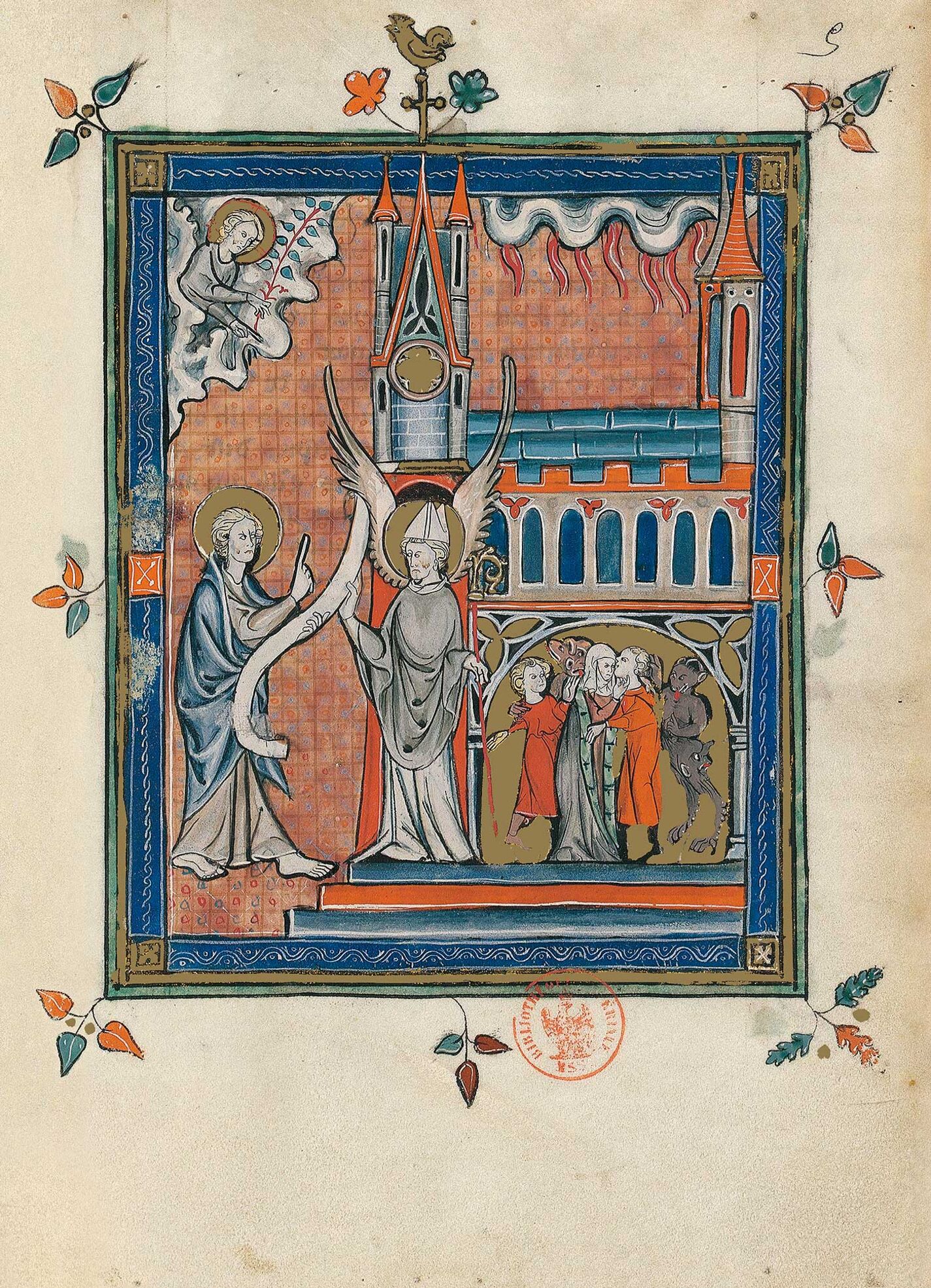The bishop of the Church of Ephesus is depicted as an early fourteenth-century prelate with the insignia of a bishop: a mitre and crosier. However, he also has a nimbus and a pair of wings evoking the title of “angel” symbolically conferred upon him in the text of the Revelation. He stands on the threshold of his cathedral, a large building whose bell tower entrance is flanked by turrets and crowned by a golden cross with a golden weather vane perched upon it.
The bishop takes the phylactery bearing the message from John. The apostle, with a stern expression, seems to be warning him against wasting his efforts and the reprehensible intrigues occurring amongst the Ephesians. Inside the church, through a wide arcature in its side wall, a demon can be seen urging a man to kiss a richly dressed woman whilst a devil with a dog’s head tries to push a third individual in between the couple. The image refers to the depravation of the Nicolaites. They were a little-known sect, founded by a certain Nicolas whom early Christian authors, such as St Irenaeus of Lyon in his treatise against heretics, gratuitously identified as Nicolas, the proselyte of Antioch, one of the seven deacons appointed by the apostles when the emergent Church began to take form (Acts 6: 1-7). In this respect the gloss abides by tradition, explaining that the deacon who had a “beautiful wife”, preached that “each man could have not only one wife but as many as he could keep”.
Above John, Christ appears in the sky holding a red rod with greenish foliage, a branch of the Tree of Life, the heavenly food promised to the righteous and the repentant, and to those who regain the charity that was the driving force of Christian Ephesus in its early days: a community whose name is said by the commentator to mean “willingness and counsel”. Already emerging from the clouds between the church towers are the flames of hell in store for those who refuse to heed God’s warning and convert.
Marie-Thérèse Gousset and Marianne Besseyre
Illuminated Manuscripts Research Center, Bibliothèque nationale de France
Fragment of the Apocalypse of 1313 commentary volume

The bishop of the Church of Ephesus is depicted as an early fourteenth-century prelate with the insignia of a bishop: a mitre and crosier. However, he also has a nimbus and a pair of wings evoking the title of “angel” symbolically conferred upon him in the text of the Revelation. He stands on the threshold of his cathedral, a large building whose bell tower entrance is flanked by turrets and crowned by a golden cross with a golden weather vane perched upon it.
The bishop takes the phylactery bearing the message from John. The apostle, with a stern expression, seems to be warning him against wasting his efforts and the reprehensible intrigues occurring amongst the Ephesians. Inside the church, through a wide arcature in its side wall, a demon can be seen urging a man to kiss a richly dressed woman whilst a devil with a dog’s head tries to push a third individual in between the couple. The image refers to the depravation of the Nicolaites. They were a little-known sect, founded by a certain Nicolas whom early Christian authors, such as St Irenaeus of Lyon in his treatise against heretics, gratuitously identified as Nicolas, the proselyte of Antioch, one of the seven deacons appointed by the apostles when the emergent Church began to take form (Acts 6: 1-7). In this respect the gloss abides by tradition, explaining that the deacon who had a “beautiful wife”, preached that “each man could have not only one wife but as many as he could keep”.
Above John, Christ appears in the sky holding a red rod with greenish foliage, a branch of the Tree of Life, the heavenly food promised to the righteous and the repentant, and to those who regain the charity that was the driving force of Christian Ephesus in its early days: a community whose name is said by the commentator to mean “willingness and counsel”. Already emerging from the clouds between the church towers are the flames of hell in store for those who refuse to heed God’s warning and convert.
Marie-Thérèse Gousset and Marianne Besseyre
Illuminated Manuscripts Research Center, Bibliothèque nationale de France
Fragment of the Apocalypse of 1313 commentary volume